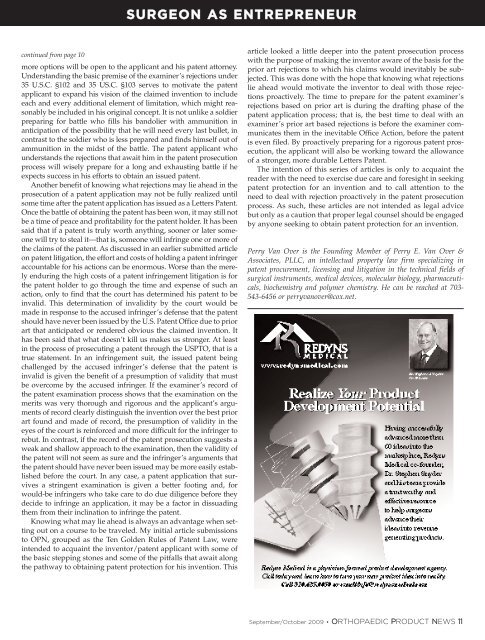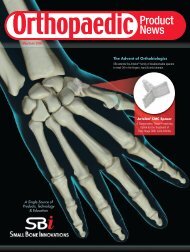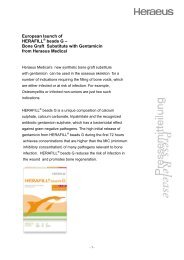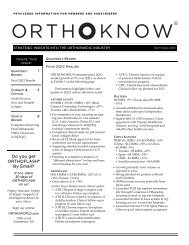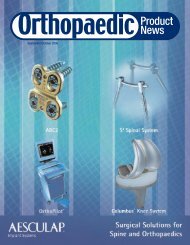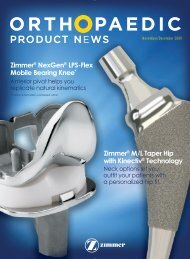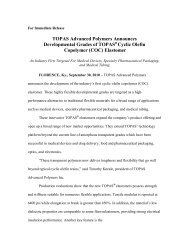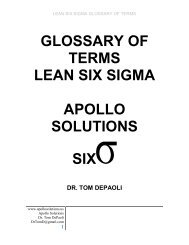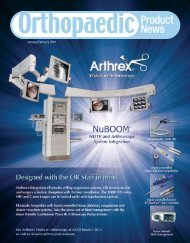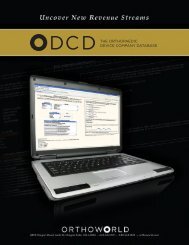Spinal Surgery, Cement Systems - Orthoworld
Spinal Surgery, Cement Systems - Orthoworld
Spinal Surgery, Cement Systems - Orthoworld
Create successful ePaper yourself
Turn your PDF publications into a flip-book with our unique Google optimized e-Paper software.
SURGEON AS ENTREPRENEUR<br />
continued from page 10<br />
more options will be open to the applicant and his patent attorney.<br />
Understanding the basic premise of the examiner’s rejections under<br />
35 U.S.C. §102 and 35 US.C. §103 serves to motivate the patent<br />
applicant to expand his vision of the claimed invention to include<br />
each and every additional element of limitation, which might reasonably<br />
be included in his original concept. It is not unlike a soldier<br />
preparing for battle who fills his bandolier with ammunition in<br />
anticipation of the possibility that he will need every last bullet, in<br />
contrast to the soldier who is less prepared and finds himself out of<br />
ammunition in the midst of the battle. The patent applicant who<br />
understands the rejections that await him in the patent prosecution<br />
process will wisely prepare for a long and exhausting battle if he<br />
expects success in his efforts to obtain an issued patent.<br />
Another benefit of knowing what rejections may lie ahead in the<br />
prosecution of a patent application may not be fully realized until<br />
some time after the patent application has issued as a Letters Patent.<br />
Once the battle of obtaining the patent has been won, it may still not<br />
be a time of peace and profitability for the patent holder. It has been<br />
said that if a patent is truly worth anything, sooner or later someone<br />
will try to steal it—that is, someone will infringe one or more of<br />
the claims of the patent. As discussed in an earlier submitted article<br />
on patent litigation, the effort and costs of holding a patent infringer<br />
accountable for his actions can be enormous. Worse than the merely<br />
enduring the high costs of a patent infringement litigation is for<br />
the patent holder to go through the time and expense of such an<br />
action, only to find that the court has determined his patent to be<br />
invalid. This determination of invalidity by the court would be<br />
made in response to the accused infringer’s defense that the patent<br />
should have never been issued by the U.S. Patent Office due to prior<br />
art that anticipated or rendered obvious the claimed invention. It<br />
has been said that what doesn’t kill us makes us stronger. At least<br />
in the process of prosecuting a patent through the USPTO, that is a<br />
true statement. In an infringement suit, the issued patent being<br />
challenged by the accused infringer’s defense that the patent is<br />
invalid is given the benefit of a presumption of validity that must<br />
be overcome by the accused infringer. If the examiner’s record of<br />
the patent examination process shows that the examination on the<br />
merits was very thorough and rigorous and the applicant’s arguments<br />
of record clearly distinguish the invention over the best prior<br />
art found and made of record, the presumption of validity in the<br />
eyes of the court is reinforced and more difficult for the infringer to<br />
rebut. In contrast, if the record of the patent prosecution suggests a<br />
weak and shallow approach to the examination, then the validity of<br />
the patent will not seem as sure and the infringer’s arguments that<br />
the patent should have never been issued may be more easily established<br />
before the court. In any case, a patent application that survives<br />
a stringent examination is given a better footing and, for<br />
would-be infringers who take care to do due diligence before they<br />
decide to infringe an application, it may be a factor in dissuading<br />
them from their inclination to infringe the patent.<br />
Knowing what may lie ahead is always an advantage when setting<br />
out on a course to be traveled. My initial article submissions<br />
to OPN, grouped as the Ten Golden Rules of Patent Law, were<br />
intended to acquaint the inventor/patent applicant with some of<br />
the basic stepping stones and some of the pitfalls that await along<br />
the pathway to obtaining patent protection for his invention. This<br />
article looked a little deeper into the patent prosecution process<br />
with the purpose of making the inventor aware of the basis for the<br />
prior art rejections to which his claims would inevitably be subjected.<br />
This was done with the hope that knowing what rejections<br />
lie ahead would motivate the inventor to deal with those rejections<br />
proactively. The time to prepare for the patent examiner’s<br />
rejections based on prior art is during the drafting phase of the<br />
patent application process; that is, the best time to deal with an<br />
examiner’s prior art based rejections is before the examiner communicates<br />
them in the inevitable Office Action, before the patent<br />
is even filed. By proactively preparing for a rigorous patent prosecution,<br />
the applicant will also be working toward the allowance<br />
of a stronger, more durable Letters Patent.<br />
The intention of this series of articles is only to acquaint the<br />
reader with the need to exercise due care and foresight in seeking<br />
patent protection for an invention and to call attention to the<br />
need to deal with rejection proactively in the patent prosecution<br />
process. As such, these articles are not intended as legal advice<br />
but only as a caution that proper legal counsel should be engaged<br />
by anyone seeking to obtain patent protection for an invention.<br />
Perry Van Over is the Founding Member of Perry E. Van Over &<br />
Associates, PLLC, an intellectual property law firm specializing in<br />
patent procurement, licensing and litigation in the technical fields of<br />
surgical instruments, medical devices, molecular biology, pharmaceuticals,<br />
biochemistry and polymer chemistry. He can be reached at 703-<br />
543-6456 or perryvanover@cox.net.<br />
September/October 2009 • ORTHOPAEDIC PRODUCT NEWS 11


